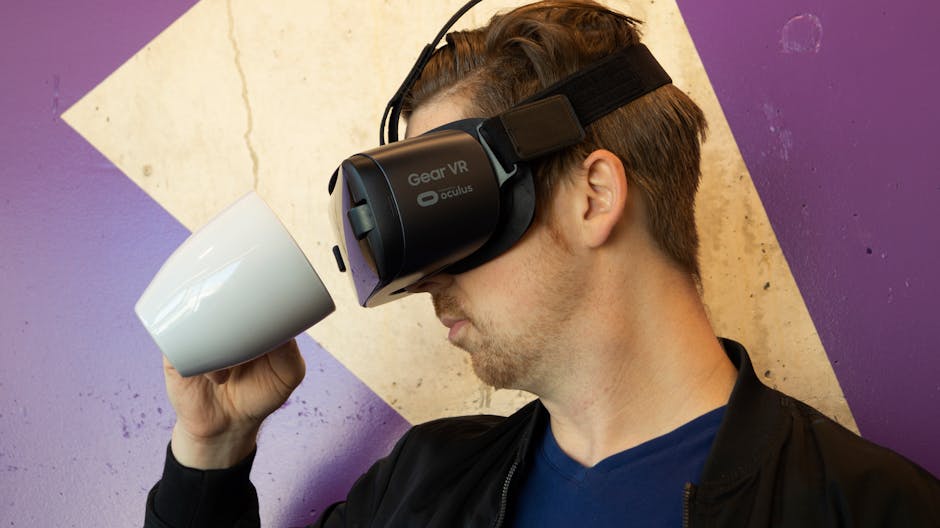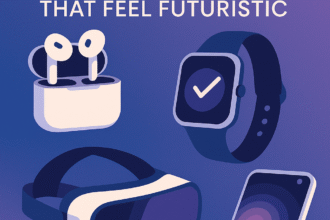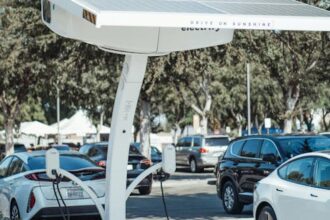From virtual try-ons to immersive training programs, augmented reality is revolutionizing how we shop, work, and entertain ourselves. Discover the cutting-edge applications reshaping three fundamental aspects of modern life.
The augmented reality revolution is no longer a glimpse into the future—it’s transforming the present. As AR technology matures and becomes more accessible, it’s fundamentally changing how consumers shop, how employees work, and how people play. The global augmented reality market size was estimated at USD 83.65 billion in 2024 and is expected to grow at a CAGR of 37.9% from 2025 to 2030, indicating massive adoption across industries.
This explosive growth isn’t just about novelty—it represents a fundamental shift in how we interact with digital information and physical spaces. AR overlays digital content onto the real world, creating experiences that are more intuitive, engaging, and effective than traditional interfaces. With millions of AR-enabled apps already available, mobile AR is being widely used for gaming, shopping, education, and enterprise applications. The global mobile augmented reality market was valued at $11.9 billion in 2024 and will run to $13.8 billion in 2025.
Here’s how AR is revolutionizing three critical areas of modern life and why these changes matter for consumers, businesses, and the broader economy.
AR Revolution in Shopping: The Retail Renaissance
Virtual Try-On Technology Transforms E-Commerce
The retail industry has embraced AR as a solution to one of e-commerce’s biggest challenges: the inability to try products before purchase. The Augmented Reality AR Shopping Market is Valued USD 3.42 billion by 2024 and projected to reach USD 31.8 billion by 2032 growing at a CAGR of 28.10% During the Forecast period of 2025-2032, demonstrating the massive consumer appetite for AR shopping experiences.
Fashion and Beauty Applications: Modern AR shopping apps enable customers to virtually try on clothing, accessories, makeup, and eyewear using their smartphone cameras. Companies like Sephora, L’Oreal, and Warby Parker have pioneered AR try-on experiences that reduce return rates and increase customer satisfaction. These applications use advanced computer vision and machine learning to accurately map digital products onto users’ faces and bodies.
Furniture and Home Decor: IKEA’s Place app and similar AR tools allow customers to visualize furniture in their actual living spaces before making purchases. This technology addresses the common problem of buying furniture that doesn’t fit or match existing decor. Customers can see exactly how a couch will look in their living room or whether a dining table will fit their space.
Automotive Industry: Car manufacturers are using AR to let customers visualize different vehicle configurations, colors, and features. BMW, Mercedes-Benz, and other luxury brands offer AR apps that place full-scale vehicle models in customers’ driveways, enabling detailed exploration of interior and exterior features.
Enhanced In-Store Experiences
Physical retail isn’t being replaced by AR—it’s being enhanced. Smart retailers are implementing AR solutions that bridge online and offline shopping experiences:
Interactive Product Information: AR apps can display detailed product information, customer reviews, and comparison data by simply pointing a smartphone at products. This instant access to information helps customers make more informed purchasing decisions.
Guided Shopping Navigation: Large retailers like Target and Walmart are testing AR navigation systems that guide customers to specific products within stores. These indoor GPS systems reduce shopping time and improve customer satisfaction.
Virtual Sales Assistants: There will be virtual assistants and AI chatbots that support you while shopping and offer personalised recommendations when both shopping online and in a physical store. We also assume future AI AR technology will allow you to ‘try on’ clothes without actually putting them on. These AI-powered AR assistants provide personalized recommendations based on customer preferences and purchase history.
Personalization and Customer Analytics
AR shopping generates valuable data about customer preferences, behaviors, and decision-making processes. Retailers use this information to:
- Personalize product recommendations
- Optimize store layouts and product placement
- Develop new products based on customer interaction patterns
- Improve inventory management by predicting demand more accurately
The result is a more personalized, efficient, and enjoyable shopping experience that benefits both consumers and retailers.
Workplace Transformation Through AR Technology
Remote Work and Collaboration Revolution
The shift to remote and hybrid work has accelerated AR adoption in professional environments. By 2025, the adoption of VR and AR technologies for immersive team interactions is expected to rise significantly. Virtual meeting rooms and augmented reality tools are enabling lifelike experiences, bridging the gap between remote and in-person collaboration.
Virtual Meeting Spaces: AR-powered meeting platforms create shared virtual environments where remote team members can collaborate as if they’re in the same room. These platforms enable:
- 3D data visualization and manipulation
- Virtual whiteboards and collaboration tools
- Spatial audio for natural conversation flow
- Gesture and eye tracking for more natural interaction
Document and Data Visualization: AR transforms how professionals work with complex information. Engineers can visualize 3D models in real space, financial analysts can manipulate data visualizations with hand gestures, and architects can walk clients through virtual building models during video calls.
Industrial Training and Skills Development
AR and VR eliminate these barriers by providing remote, on-demand training that can be accessed anytime, anywhere. Companies can standardize training across locations without additional infrastructure investments. Every employee learns at their own pace, and one-size-fits-all training programs are being replaced by personalized AR learning experiences.
Manufacturing and Assembly Training: Boeing, General Electric, and other manufacturing giants use AR to train workers on complex assembly processes. AR overlays provide step-by-step instructions, highlight safety protocols, and offer real-time feedback on performance. This approach reduces training time, improves retention, and decreases errors.
Medical Training: Healthcare professionals use AR for surgical training, anatomy education, and patient diagnosis. Medical students can examine virtual organs, practice procedures on digital patients, and access expert guidance through AR interfaces. This technology makes advanced medical training more accessible and cost-effective.
Maintenance and Repair: High-standard industrial training at scale with AR. There is a growing need for high-standard industrial training at scale to be more efficient and augmented reality (AR) is leading the way businesses can train staff remotely. As access to augmented reality headsets increases, with portable AR systems, technicians can receive expert guidance while performing complex repairs on industrial equipment.
Enhanced Productivity and Safety
Real-Time Information Access: AR provides workers with instant access to manuals, procedures, and expert assistance without interrupting their workflow. This reduces downtime and improves efficiency across industries.
Safety Training and Compliance: AR simulates dangerous scenarios safely, allowing workers to practice emergency procedures without risk. Oil and gas companies, construction firms, and chemical manufacturers use AR to train workers on safety protocols and emergency response.
Quality Control and Inspection: AR overlays help inspectors identify defects, measure tolerances, and ensure compliance with specifications. This technology improves accuracy while reducing inspection time and costs.
Remote Assistance and Expert Support
Whether you have remote employees or your workplace is distributed across multiple sites, AR training makes it possible to deliver engaging training to all. Using AR, you can provide virtual training that ties into the employee’s location, and deliver on-screen information and prompts.
Field service technicians can receive real-time guidance from experts located anywhere in the world. This capability is particularly valuable for:
- Complex equipment maintenance
- Troubleshooting rare problems
- Training new employees in remote locations
- Reducing travel costs for expert consultations
Gaming and Entertainment Evolution
Next-Generation Gaming Experiences
Augmented reality gaming market size reached USD 14.2 Billion in 2024, Expected to Hit USD 141.7 Billion, CAGR of 25.9% during 2025-2033. This explosive growth reflects AR’s ability to create entirely new categories of gaming experiences.
Location-Based AR Gaming: Games like Pokémon GO pioneered location-based AR gaming, encouraging players to explore real-world locations while interacting with virtual creatures and objects. This approach combines physical activity with digital entertainment, creating more engaging and social gaming experiences.
Multiplayer AR Adventures: Modern AR games enable multiple players to share the same augmented space, collaborating or competing in mixed reality environments. These games can transform any location into a gaming arena, from living rooms to entire neighborhoods.
Educational Gaming: AR educational games make learning more interactive and memorable. Students can explore historical sites through AR, conduct virtual science experiments, and visualize complex mathematical concepts in three dimensions.
Social Media and Content Creation
AR Filters and Effects: Social media platforms like Instagram, Snapchat, and TikTok have made AR accessible to billions of users through filters and effects. These tools enable creative expression and have spawned new forms of digital art and communication.
Interactive Storytelling: AR enables new forms of narrative entertainment where stories unfold in users’ physical spaces. Publishers, filmmakers, and game developers are experimenting with AR to create immersive storytelling experiences that blend digital content with real-world environments.
Virtual Concerts and Events: The entertainment industry uses AR to create unique live experiences. Virtual concerts, art exhibitions, and interactive performances can be enjoyed from home while providing shared social experiences with other attendees.
Personalized Entertainment
AR and VR can support games that are more engaging and attuned to the preferences of the individual customer, maximizing their satisfaction and boosting revenue in the process. For AR and VR to become the global mainstream success that it could be, there are some challenges to address along the way.
Adaptive Gaming Environments: AI-powered AR systems create gaming experiences that adapt to individual preferences, skill levels, and playing styles. This personalization keeps players engaged longer and provides more satisfying entertainment experiences.
Context-Aware Entertainment: AR entertainment applications can adapt to users’ locations, time of day, and social context. A morning commute might trigger educational AR content, while evening relaxation time could activate entertainment-focused applications.
Market Impact and Economic Implications
Investment and Industry Growth
The AR industry is attracting massive investment from technology giants, venture capital firms, and strategic investors. The market is projected to grow from USD 140.34 billion in 2025 to USD 1,716.37 billion by 2032, exhibiting a CAGR of 43.0% during the forecast period. North America dominated the global market with a share of 31.29% in 2024.
This investment is funding:
- Hardware development (AR glasses, headsets, and mobile devices)
- Software platforms and development tools
- Content creation and distribution systems
- Infrastructure for AR cloud computing
Job Creation and Skills Development
The AR revolution is creating new career opportunities across industries:
- AR/VR developers and designers
- 3D content creators and artists
- AR experience strategists
- Industrial AR specialists
- AR marketing and advertising professionals
Educational institutions are responding by developing AR-focused curricula and training programs to meet growing demand for skilled professionals.
Consumer Adoption Trends
In 2023, the mobile AR market was worth $21.1 billion, while the AR software market reached $11.6 billion and the AR advertising market $4.3 billion. The AR & VR market is predicted to nearly double between 2025 and 2028. Mobile AR market revenue is expected to top $39 billion in 2027.
Consumer adoption is accelerating due to:
- Improved smartphone AR capabilities
- More affordable AR hardware
- Compelling use cases across shopping, work, and entertainment
- Better user interfaces and experiences
Challenges and Future Outlook
Technical Challenges
Despite rapid progress, AR technology faces several challenges:
Hardware Limitations: Current AR devices often suffer from limited battery life, processing power, and display quality. However, advances in chip design, optics, and battery technology are steadily addressing these issues.
Network Requirements: Advanced AR experiences require high-speed, low-latency internet connections. The rollout of 5G networks is essential for mobile AR adoption, particularly for applications requiring real-time collaboration or complex rendering.
User Interface Design: Creating intuitive AR interfaces remains challenging. Designers must balance functionality with usability while ensuring AR experiences feel natural and non-intrusive.
Privacy and Security Concerns
AR applications collect vast amounts of personal data, including location information, visual data, and behavioral patterns. Companies must address:
- Data privacy and security protocols
- Transparent data collection practices
- User consent and control mechanisms
- Compliance with privacy regulations
Social and Cultural Impact
Digital Divide: AR technology risks creating new forms of inequality between those who have access to advanced AR experiences and those who don’t. Ensuring equitable access to AR technology is crucial for maximizing its societal benefits.
Real-World Integration: As AR becomes more prevalent, society must adapt to new norms around digital overlays in public spaces, AR advertising, and the blending of virtual and physical experiences.
The Road Ahead: 2025-2030
Technology Convergence
The AR/VR space is evolving rapidly. In 2025, the focus will be on enhancing the user experience with smarter, more adaptable technologies, improving both usability and content. Bringing artificial intelligence into AR and VR solutions has completely changed the game.
The integration of AI with AR will enable:
- More realistic virtual objects and environments
- Better understanding of user context and intent
- Automated content generation and personalization
- Improved computer vision and spatial understanding
Mainstream Adoption Milestones
Several developments will accelerate AR adoption:
- Apple’s Vision Pro and similar devices making AR more accessible
- Improved AR capabilities in mainstream smartphones
- 5G network expansion enabling advanced mobile AR experiences
- Industry-specific AR solutions proving ROI in enterprise settings
New Application Areas
Emerging AR applications include:
- Healthcare diagnosis and treatment planning
- Education and professional development
- Smart city infrastructure and navigation
- Environmental monitoring and sustainability
- Cultural preservation and virtual tourism
Conclusion: Embracing the AR-Enhanced Future
Augmented reality is transforming shopping, work, and play in ways that seemed impossible just a few years ago. From virtual try-on experiences that reduce return rates to immersive training programs that improve safety and efficiency, AR is delivering tangible benefits across industries.
The statistics tell a compelling story: with market projections reaching over $1.7 trillion by 2032 and adoption rates accelerating across consumer and enterprise segments, AR is transitioning from experimental technology to essential infrastructure.
For consumers, AR offers more personalized, convenient, and engaging experiences. For businesses, it provides competitive advantages through improved customer experiences, enhanced training programs, and more efficient operations. For society, it promises more accessible education, better healthcare outcomes, and new forms of creative expression.
The AR revolution is just beginning. As hardware improves, content becomes more sophisticated, and integration deepens across industries, the boundary between physical and digital worlds will continue to blur. Organizations and individuals who embrace AR technology now will be best positioned to benefit from the opportunities it creates.
The future isn’t about choosing between physical and digital experiences—it’s about seamlessly blending them to create something more powerful than either could achieve alone. Augmented reality is making that future a reality today.
For the latest developments in AR technology, visit Augmented Reality for Enterprise Alliance (AREA), explore consumer trends at AR Insider, and follow industry research through IDC Augmented Reality Research. Stay informed about AR investments and startups through VentureBeat AR/VR.








